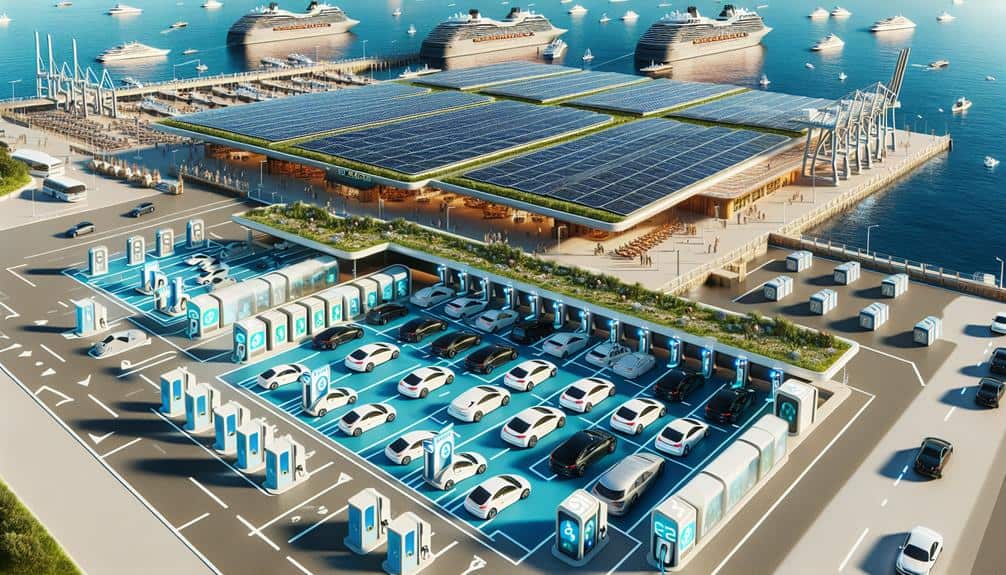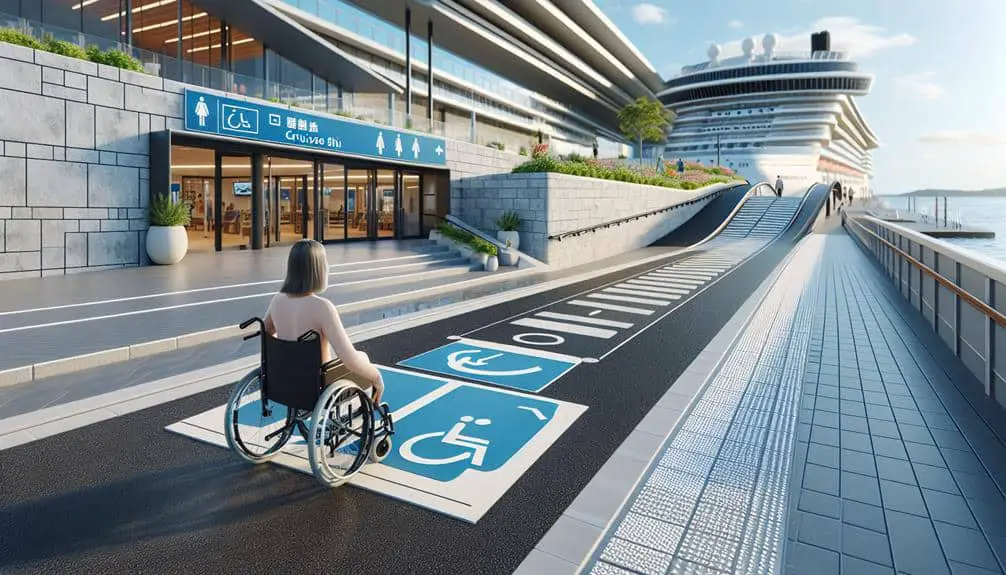Prioritizing sustainable practices at cruise port facilities is essential. High carbon emissions from ships and poor waste management harm the environment. By adopting cleaner fuels and efficient technologies, emissions can decrease. Proper waste segregation and recycling programs prevent coastal pollution. Sustainability not only cuts costs but also enhances air quality and reputation. Innovations like smart tech and renewable energy showcase commitment. Engaging with communities and educating them boosts support. Economically, sustainability saves money, attracts eco-conscious travelers, and builds a strong brand image. Prioritizing sustainability at ports is key to a green future.
Key Points
- Reduce carbon emissions and environmental impact.
- Lower operating costs and improve air quality.
- Enhance reputation, attract eco-conscious travelers.
- Ensure regulatory compliance and positive community relations.
- Position for sustained success and market demand.
Environmental Impact of Cruise Ports
When evaluating the environmental impact of cruise ports, it's essential to take into account the complex interplay between maritime activities and the surrounding ecosystems. Cruise ships are significant contributors to carbon emissions due to their high fuel consumption. Implementing strategies to reduce these emissions, such as using cleaner fuels or adopting more fuel-efficient technologies, is vital for mitigating the environmental footprint of cruise ports.
Effective waste management is another key aspect that directly impacts marine conservation efforts. Improper disposal of waste can lead to coastal pollution, endangering marine life and ecosystems. By implementing proper waste segregation, recycling programs, and wastewater treatment facilities, cruise ports can notably reduce their negative impact on the environment.
Promoting marine conservation through initiatives like coral reef protection and biodiversity preservation is essential for maintaining the ecological balance in the areas surrounding cruise ports. Prioritizing these aspects is fundamental in ensuring the sustainability of cruise port operations while minimizing their environmental footprint.
Benefits of Sustainable Practices
Implementing sustainable practices at cruise port facilities not only benefits the environment but also enhances operational efficiency and community relations. By focusing on reduced emissions and improving energy efficiency, cruise ports can achieve the following:
- Lower Operating Costs: Implementing energy-efficient technologies can lead to reduced energy consumption, resulting in cost savings for the port facilities.
- Improved Air Quality: By reducing emissions from cruise ships and port operations, sustainable practices help in improving the air quality in and around the port area, benefiting both the local community and the environment.
- Enhanced Reputation: Embracing sustainable practices can enhance the reputation of cruise port facilities, attracting environmentally conscious travelers and fostering positive community relations.
- Regulatory Compliance: Adhering to sustainable practices guarantees cruise ports comply with environmental regulations, avoiding potential fines and legal issues while promoting a culture of responsibility and stewardship.
Innovations in Port Facilities
To drive forward sustainable initiatives and stay at the forefront of environmental stewardship, exploring innovative solutions in port facilities is imperative for cruise industry stakeholders. Incorporating smart technology into port operations can greatly enhance efficiency and reduce environmental impact. Smart technology applications such as automated energy management systems, real-time monitoring of energy consumption, and predictive maintenance algorithms can optimize energy usage and minimize waste.
Moreover, integrating renewable energy sources like solar panels, wind turbines, or even wave energy converters into port infrastructure can help reduce dependency on traditional fossil fuels. By harnessing renewable energy, port facilities can lower greenhouse gas emissions and contribute to a cleaner, more sustainable environment. Additionally, implementing energy storage solutions like advanced batteries can store excess energy generated from renewables for later use, ensuring a constant and reliable power supply.
Innovations in port facilities not only showcase a commitment to sustainability but also pave the way for a more efficient and eco-friendly cruise industry. By embracing smart technology and renewable energy, cruise port facilities can lead the charge towards a greener future.
Community Engagement and Support
Engage with local communities strategically to garner support for sustainable initiatives at cruise port facilities. Establishing strong community engagement and support is vital for the success of sustainability efforts. Here's how you can effectively involve stakeholders and build local partnerships:
- Community Consultations: Conduct regular meetings with community members to gather feedback, address concerns, and guarantee their voices are heard in decision-making processes.
- Educational Workshops: Organize workshops to educate the community about the significance of sustainable practices at cruise ports, fostering understanding and buy-in for initiatives.
- Collaborative Projects: Partner with local organizations and businesses to implement joint sustainability projects, creating a sense of shared responsibility and promoting collective action.
- Transparency and Communication: Maintain open communication channels with the community through newsletters, social media, and public forums to provide updates on sustainability progress and encourage ongoing engagement.
Economic Advantages of Sustainability
Strategically aligning sustainable practices with economic benefits can result in a win-win scenario both for cruise port facilities and the local communities they serve. Embracing sustainability can lead to significant cost savings for cruise port facilities in the long run. Energy-efficient lighting, water conservation measures, and waste reduction strategies not only lower operational expenses but also enhance the overall efficiency of port operations.
Moreover, sustainability is becoming increasingly intertwined with market demand. Travelers are more conscious of environmental issues and are actively seeking out eco-friendly travel options. By prioritizing sustainable practices, cruise port facilities can attract a growing segment of environmentally conscious passengers, leading to increased business opportunities and revenue streams.
Investing in sustainability initiatives not only benefits the bottom line but also strengthens the reputation and brand image of cruise ports. By demonstrating a commitment to environmental stewardship, ports can differentiate themselves in a competitive market and build long-term relationships with customers and stakeholders. The economic advantages of sustainability go beyond immediate cost savings, positioning cruise port facilities for sustained success in a rapidly evolving industry.
Frequently Asked Questions
What Are the Challenges Faced in Implementing Sustainable Practices at Cruise Port Facilities?
Facing funding challenges and fostering stakeholder engagement, you must navigate the complexities of implementing sustainable practices at cruise port facilities. Balancing budget constraints and garnering support are key hurdles to overcome for lasting environmental impact.
How Do Cruise Port Facilities Mitigate Noise Pollution for Surrounding Communities?
To reduce noise pollution and interact with communities, cruise port facilities implement advanced technology solutions like noise barriers and quieter equipment. Community engagement guarantees understanding and cooperation, creating a harmonious relationship between the port and its surroundings.
Are There Any Specific Regulations or Guidelines in Place to Ensure Cruise Port Facilities Adhere to Sustainable Practices?
To guarantee regulatory compliance, cruise port facilities must conduct environmental impact assessments. These assessments help evaluate the effects of operations on the environment and guide sustainable practices. Adhering to guidelines fosters responsible stewardship of resources and ecosystems.
How Do Cruise Port Facilities Handle Waste Management and Recycling Initiatives?
When it comes to waste management, cruise port facilities prioritize waste reduction through efficient recycling initiatives. By implementing energy-efficient practices, they aim to minimize environmental impact and promote sustainability in handling waste, contributing to a greener future.
What Measures Are in Place to Protect Local Wildlife and Ecosystems Near Cruise Port Facilities?
To protect local wildlife and ecosystems near cruise port facilities, stringent regulations govern waste disposal and emissions. Wildlife conservation is prioritized through habitat restoration projects, while ecosystem preservation is guaranteed by monitoring and minimizing human impact.



